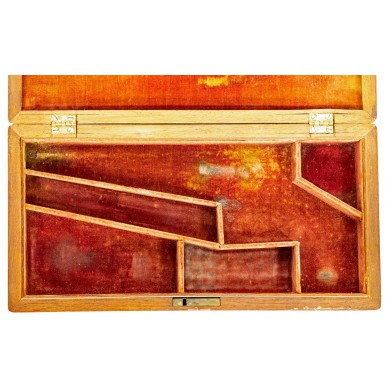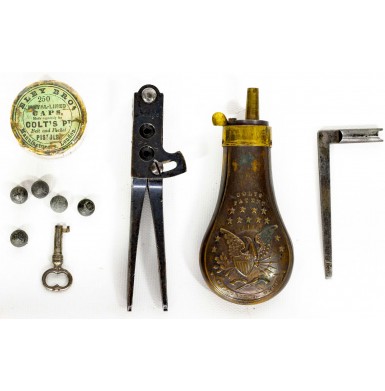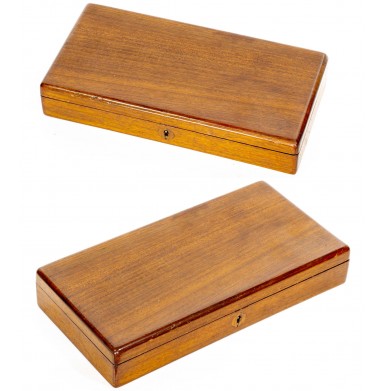Attractive Cased Colt 1862 Pocket Model of Navy Caliber
- Product Code: FHG-2311-SOLD
- Availability: Out Of Stock
-
$1.00
In 1861 Colt introduced two new pocket model revolvers in their more powerful .36 caliber chambering. Until that time, all of Colt’s “Pocket” guns had been .31 caliber, or in the case of some of the Root revolver production revolvers the even smaller .28 caliber. These new pocket revolvers can be considered “scaled up” 1849 Pocket Models or scaled down Belt Pistols (aka “Navy” models), as both guns had features drawn from their smaller and larger predecessors. The two new models were known as the Model 1862 Police and the Model 1862 Pocket Revolver of Navy Caliber. The “Police” model resembled a scaled down, early production Colt Model 1861 New Model Belt (Navy) Revolver, built on a Colt 1849 Pocket frame. The .36 caliber revolver had a five shot fluted cylinder and the grip frame and triggerguard were of Colt Pocket size and style. It had a round barrel, a creeping loading lever and was available in 3 ½”, 4 ½”, 5 ½” and 6 ½” barrel lengths. The Pocket Navy was essentially a scaled down Model 1851 Navy Revolver, again built on an 1849 Pocket frame, with a .36 caliber, five shot, rebated round cylinder that was roll engraved with the same Stagecoach Hold Up scene used on the 1849 Pocket Model. Like the Police model it used a Pocket sized frame and triggerguard but had an octagonal barrel and conventional swinging link loading lever like those used on the M1849 and M1851 revolvers. Like the Police, it was available in four barrel lengths from 3 ½” to 6 ½”, in 1” increments. Both revolver models came standard with blued barrels and cylinders, color casehardened frames and silver-plated brass backstraps, gripstraps and triggerguards. A few of the revolvers were produced with iron grip frames and triggerguards, which were also silver plated, but these are only found on very low number, early production revolvers. The earliest production revolvers will be found with the desirable Hartford barrel address, but the majority of the production carried the typical one-line New York barrel address. Although both models are referred to with the model date of 1862, both went into production during 1861, and would remain in production until the end of the Colt percussion era in 1873. During that time same 47,000 of both models would be produced. The guns were manufactured concurrently and utilized the same serial number series, regardless of model, so the models are interspersed randomly within that serial number range. According to Colt researcher and author R.L Wilson, it is believed that about 60% of the total production of the two models was of the 1862 Police pattern, which would be approximately 28,200 guns, produced over about the thirteen year production period. Thus, the remaining 40% was of the Pocket Navy variety, or only about 18,800 of those guns produced over the same time frame. When compared to the superstars of the Colt percussion revolver product line, like the 1849 Pocket Model, this represented about an average single year of 1849 production. Colt manufactured approximately 331,000 1849 Pocket Models over roughly twenty-four years, averaging about 13,800 per year. This means that Colt manufactured more than seventeen M1849 Pocket Models for every 1862 Pocket Navy that was produced, or that Colt 1862 Pocket Navy only represented about 6% of the production when compared to the venerable 1849 Pocket. For that reason, these guns are much less common on the collector market today than its smaller sibling.
Offered here is a FINE condition Colt Model 1862 Pocket Revolver of Navy Caliber, in an original Colt factory casing with a number of original, period accessories. The gun is a one of the 5 ½” octagonal barreled guns and is serial number 3909, placing its production in 1861. The gun has matching numbers throughout on all parts, including the wedge and the grip, with the exception of the loading lever, which is not numbered. The gun has the standard rebated round cylinder with roll engraved Stagecoach Holdup scene. The top of the barrel is roll marked in a single line:
ADDRESS COL SAML COLT NEW-YORK U.S. AMERICA
The lower left side of the frame, forward of the cylinder is marked in two lines: COLT’S / PATENT which was double struck, or the die hopped when it was hit, resulting in an off-set shadow appearance to the letters. The left rear web of the triggerguard is marked 36 CAL. The cylinder has the usual boxed COLT’S PATENT marking over the boxed serial number marking No 3909. The revolver retains a large amount of its original finish, with about 85% of the original deep blue on the barrel and some strong traces of vivid case color in the protected areas of the frame, primarily behind the recoil shield. The barrel shows most of its finish loss as high edge wear along the sharp edges and contact points and around the muzzle in the form of holster wear. As usual, the barrel web shows some scattered impact marks around the wedge on both sides. There are also a few scattered impact marks on the barrel itself, mostly along the edges of the top flat. The barrel is smooth and free of any real pitting but does show some moderate pinpricking on the flat of the muzzle and around the forcing cone, as well as some lightly scattered pinpricking here and there. There is also some scattered surface oxidation here and there, with oxidized flecks scattered throughout the remaining blue. The frame has faded to a mostly dull dove gray patina with some scattered areas of soft mottling from the case coloring and some traces of more vivid color in the protected areas. There is an area of surface scuffing on the right side of the frame that was probably poorly executed attempt to clean some surface oxidation or discoloration. The frame is also free of any real pitting but does show some flecks of surface oxidation and some very minor flecks of pinpricking. The cylinder retains about 20% of its original blue, most of which is in the protected rebated portion of the cylinder at its rear, with some traces on the larger portion of the cylinder. The cylinder retains the large majority of its roll engraved scene, rating at least 90%+. The periphery of the cylinder is free of any pitting, but both the cone (nipple) recesses at the rear of the cylinder and the face of the cylinder show moderate amounts of oxidation and erosion from cap flash and hot gasses, as well as some light pinpricking. The hammer retains some traces of dull and faded case coloring with more of the dulled blues and purples visible on the right side than the left and with some oxidized etching and wear on the left side of the hammer. The loading lever retains some vivid case color on the web with the majority of the lever having a dull, smoky gray patina. Although the lever is unnumbered its patina and wear match the balance of the gun so perfectly there is no indication that the lever is a replacement and has clearly been with the pistol for its entire life. The brass gripstrap, backstrap and triggerguard retain none of their silver plated finish and have a rich, uncleaned and untouched ochre patina. The bore of the revolver is in about FINE condition as well and is mostly bright with crisp rifling and showing only some lightly scattered pitting along its length, mostly in the grooves. The original truncated brass cone front sight is in place on the top of the barrel, near the muzzle. All of the cones appear to be original and remain in place at the rear of the cylinder. They show light to moderate wear but remain fairly crisp and quite usable. The remnants of the original safety pins remain in place on the rear of the cylinder, but all are battered and worn down to mostly shapeless lumps. The screws all remain fairly sharp and crisp, and most retain at some least traces of their original faded fire-blued finish. Only a couple of the screws show more than some light slot wear. The revolver is in VERY GOOD mechanical condition and times, indexes and locks up as it should, as long as the revolver is operated briskly. Like many 150+ year old guns, the springs are showing some age, particularly the hand spring, so if the gun is operated very slowly, it will sometimes short-stroke or fail to properly index. Again, when operated as it would be in normal use, it functions exactly as it should. The one-piece walnut grip is in about VERY GOOD condition and remains solid and free of any breaks, cracks or repairs. The grip retains some strong traces of its original varnish and shows moderate wear, slightly more wear than the metal of the gun. This suggests the gun was carried a lot, in a fashion where a holster flap or clothing rubbed the grips regularly. There is wear and rounding to the lower flared edges of the grips and some minor chipping at the leading edge of the toes on both sides. The grip shows a moderate amount of scattered wear, including bumps, dings, surface mars and some rubs and scuffs.
The revolver is accompanied by a NEAR FINE condition Colt factory case that is correct for this revolver. It is impossible to know if the case itself it original to the gun, but often guns, cases and their accessories have been married over the last hundred years. The case retains much of its original varnish with some moderate amounts of light surface wear on the exterior, including some bumps, dings and light surface scratches. There is a small area of chipped wood loss on the lower rear edge of the case that has uneven wear as if the loss was from long term vibration against sharp surface. This area is slightly less than 4” wide and only about ½” wide at the widest point. Otherwise, the case is solid and free of any major structural damage, breaks, major cracks or significant rears. The interior of the case is lined in a marron velveteen that appears to be the original case lining. The lining shows moderate wear and some fabric loss due to the rubbing of the contents on the lining over the years. The lining also shows significant fading, with much of the interior having lightened to a more reddish tan color than the original deep maroon. The dividers shows moderate wear and a couple of old glue repairs to shore up loose sections of the case. The case contains a number of original period accessories for display with the revolver. These include the original key for the case, which still operates the lock correctly, a correct style Eagle & Stars Powder Flask, a correct blued iron 36P marked bullet mold, an original, unopened tin of Eley Brothers percussion caps, and original Colt L-shaped combination tool and some correct pattern round and conical lead projectiles.
The flask is in VERY GOOD condition and has a rich, uncleaned patina and retains much of the original lacquer. The embossed decorations of a spread-winged Eagle with the Shield of Columbia, surrounded by a background of stars and surmounting a pair of crossed pistols remains very crisp, as does the COLT’S PATENT marking over the stars. The top remains securely attached with a crisply operating charger. The spout may be for an 1849 Pocket, rather than a Pocket Navy, but this pattern of flask was the one used for all three models, the 1849 and both of the 1862 Pocket models. There is some very minor separation along about half of the seam, but it minor enough that you have to look for it, and flask remains solid and tight throughout. The mold is in VERY GOOD condition as well and shows moderate wear and the numerous small impact marks that seem to appear on most Colt molds. The COLT’S / PATENT mark on the sprue cutter and the 36P mark on the mold body are both clear and crisp. The mold retains about 85%+ of the blued finish and the cavities remain in mostly bright, crisp condition. The paper-wrapped tin of Eley Brothers percussion caps is also in VERY GOOD condition. It appears unopened and is wrapped plastic to protect it. The paper shows mottled mildew discoloration. The label retains mostly clear and fully legible printing. The green label has faded to a light green color and shows some minor loss due to age and wear. The L-shaped Colt combination tool that incorporates a cone wrench and screwdriver is in VERY GOOD condition also. It retains much of its blued finish with some thinning, fading and loss. The tool is an original Colt tool but is sized for a Colt Navy rather than a Pocket Navy revolver. This is not immediately obvious, other than it is a little too big for the cones. A small number of original lead bullets in VERY GOOD condition are included as well, six conical and three round balls.
Overall, this is very attractive and desirable example of a scarce Cased Colt 1862 Pocket Model of Navy Caliber. These are relatively scarce guns with very limited production when compared to the 1849 Pocket and the 1851 Navy revolvers. The casing is very nice and completely authentic with a nice grouping of original Colt accessories. This is a high condition gun that displays very well in a nice casing that is fairly priced would be fine addition to any collection of Colt percussion revolvers or Civil War era handguns.
SOLD
Tags: Attractive, Cased, Colt, 1862, Pocket, Model, of, Navy, Caliber

















